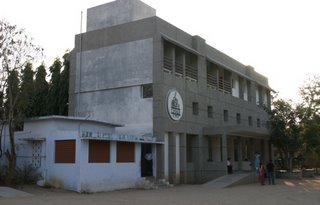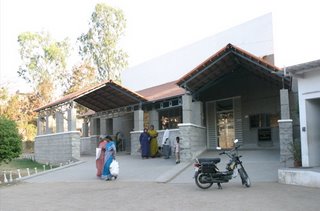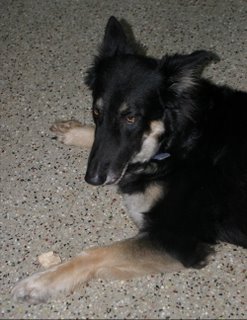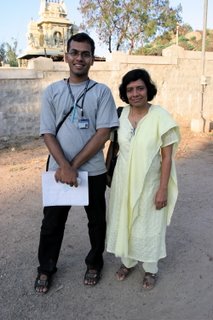Hanging at CHAD with Dr. Daisy
Tuesday, March 7, 2006
I spent the day today with an old friend of mine, Dr. Daisy. She seems to run CHAD, one of the rural branches of CMC. (CHAD is short for Community Health and Development.) She is a Community Physician, but has a diploma in OB/GYN, and runs a labor unit that does 200-300 deliveries a month.
This is what the older section of CHAD looks like:
 When I first came to Vellore in 1998, this was the entirety of the hospital. Today this building houses offices, casualty (ER), and some wards. That is because, sometime after 2000, this building was put up right next to it, thanks to a grant from the Danish government:
When I first came to Vellore in 1998, this was the entirety of the hospital. Today this building houses offices, casualty (ER), and some wards. That is because, sometime after 2000, this building was put up right next to it, thanks to a grant from the Danish government: It is here that the new labour wards (which were sorely needed), new operating theatres, and new OPD (Outpatient Department, i.e. clinics) are located. And it is here that I spent my day with Daisy. We rounded in the morning, and attended a birth in the labour ward. The births are purposely kept low tech, in part because one of CHAD's main purposes is to train community physicians who will later work in rural areas, and they need to be able to function in a low tech environment. There are no fetal monitors, and no anesthesiologists. Fetal heart tones are listened to with stethoscopes or fetoscopes, contractions are palpated with the palm of the hand, and the doctors learn to give their own anesthesia.
It is here that the new labour wards (which were sorely needed), new operating theatres, and new OPD (Outpatient Department, i.e. clinics) are located. And it is here that I spent my day with Daisy. We rounded in the morning, and attended a birth in the labour ward. The births are purposely kept low tech, in part because one of CHAD's main purposes is to train community physicians who will later work in rural areas, and they need to be able to function in a low tech environment. There are no fetal monitors, and no anesthesiologists. Fetal heart tones are listened to with stethoscopes or fetoscopes, contractions are palpated with the palm of the hand, and the doctors learn to give their own anesthesia.
(Here we see one of the nurses caring for a newborn)
We then went to OPD, to the high risk clinic. It is in the new building, and is absolutely gorgeous. There are comfortable seats for the waiting patients, and a cool, pleasant environment.
 The work area is quite nice, too. It is computerized, so lab results can be called up, and procedures and investigations ordered quite easily. We at LCECU envy them for this. The registrars (residents) and staff doctors see the patients, bringing the complicated OB and some GYN cases to Daisy. Here she is shown consulting with a patient and her mother. (Most pregnant women go through their pregnancy with their mother at their side, not their husband. Men aren't allowed in delivery rooms, only women, largely because they are still semi-private.)
The work area is quite nice, too. It is computerized, so lab results can be called up, and procedures and investigations ordered quite easily. We at LCECU envy them for this. The registrars (residents) and staff doctors see the patients, bringing the complicated OB and some GYN cases to Daisy. Here she is shown consulting with a patient and her mother. (Most pregnant women go through their pregnancy with their mother at their side, not their husband. Men aren't allowed in delivery rooms, only women, largely because they are still semi-private.) We saw a lot of patients, and then visited the labour ward again to see a new patient. It was a young girl, maybe 15 or 16 years old, and pregnant with her first child. (She was, of course, married. Everyone in India is married. It is rare to find a single person--divorced, yes, widowed, yes, but single? Hardly ever.) She had sudden developed massive vulvar edema (swelling of the female genital organs), which is horribly painful. She was a "tribal" from up in the hills, and spoke a language that was barely understood. Her village will have been high up in the mountains, and she would have had to have been carried a long way to the nearest road, and then brought down by bullock cart. It must have been horrible.
We saw a lot of patients, and then visited the labour ward again to see a new patient. It was a young girl, maybe 15 or 16 years old, and pregnant with her first child. (She was, of course, married. Everyone in India is married. It is rare to find a single person--divorced, yes, widowed, yes, but single? Hardly ever.) She had sudden developed massive vulvar edema (swelling of the female genital organs), which is horribly painful. She was a "tribal" from up in the hills, and spoke a language that was barely understood. Her village will have been high up in the mountains, and she would have had to have been carried a long way to the nearest road, and then brought down by bullock cart. It must have been horrible.And now, here she was among strangers, is a scary place, barely able to communicate, and having to bare her private parts to them. Dr. Daisy spoke gently and quietly to her; we gave her some pain medication, and then punctured the skin in may places with a fine needle, and compressed the edematous fluid. The water ran out, the pain diminished, and then she was able to sleep.
Another patient delivered, a few more were assessed, and then, at two, we broke for lunch. Daisy took me to her house, new since I saw her last, and new in general. CMCH provides housing for its senior staff, and Daisy had a lovely two story house on the Bagayam campus, with flowers and trees all around. One misses that at main CMC where, even at night, the air horns sound and the air smells of fire, dust and spice. Daisy has two quite large german shepherds, who I got to meet.
They are quite friendly and enthusiastic dogs. The male, Trigger, was a bit bigger than the female, Zeta, but he was more mellow, too. She was quite inquisitive, and insisted on inserting herself into any activity. He like being scratched, and had to be lured away from the table with treats. We had a lovely lunch, finished off by papaya from Daisy's own garden.

 (Mandatory dog photos for my nieces. Zeta sits in the upper photo, while Trigger performs tricks in the lower one.)
(Mandatory dog photos for my nieces. Zeta sits in the upper photo, while Trigger performs tricks in the lower one.)After lunch, we scanned. Daisy had recently gotten a new ultrasound machine, and we had fun figuring it out and putting it through its paces. I had looked forward to this for two reasons--I enjoy ultrasound, and the scanner is kept in an air conditioned room. It was quite hot out now, and the thought of AC was so tantalizing......so of course it was not to be. Power cut. Emergency power for the scanner (which really should be kept cool), but not for the fan or AC. So we sat still, drank lots of water, and scanned. And I fanned myself with a handy copy of the CMC Alumni Journal.
(Daisy told me that one of the problems she has this time of year is dehydration of her pregnant women. They do not drink enough water. There all sort of old wives' tales about drinking water and catching cold, or not eating watermelon--which is plentiful now--or limes--which have vitamin C--during certain months. She tries to educate, but it is hard to unlearn what mothers have taught us.)
Daisy tries to involve men in their wives' pregnancies wherever she can--in this case, by bringing them into the scan room, and showing them the baby. They all seem to enjoy it, and it helps to make the husbands participants in the pregnancy instead of onlookers. Most were good scans, most were healthy babies. But we did have some bad news--a baby that had died in utero, another that wasn't growing as well as it should
Just as we were finishing, the power came back on. We did our last scan, and then went to casualty. a patient had just been brought in with vomiting in pregnancy. And incidental heart failure. At least, that was the order the registrar presented the problems in. It was a horrible case--an 18 year old girl, with severe rheumatic heart disease, pregnant with twins. She was short of breath. No wonder. She should never have gotten pregnant, much less with twins. Her mitral valve barely functioned, and she was very pale, very anemic. All we could do was give her oxygen, and transfer her, by ambulance to the main hospital.
It was death by marriage. All women must be married, or they have no place in society (at least in the lower castes/classes). And they must immediately get pregnant, to prove their fertility to their in-laws. Otherwise they risk being divorced. This poor girl, in horrible health to start with, will most likely die if she carries this pregnancy anywhere near term. Or if she gets pregnant again and tries to bear a child. But she has no worth unless she does.
This is everyday life in India.
 Dr. Daisy and one of her registrars. I promised him I would post this photo on line.
Dr. Daisy and one of her registrars. I promised him I would post this photo on line.


0 Comments:
Post a Comment
<< Home